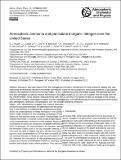Atmospheric ammonia and particulate inorganic nitrogen over the United States
Author(s)
Heald, Colette L.; Collett, J. L., Jr.; Lee, T.; Benedict, K. B.; Schwandner, F. M.; Li, Y.; Clarisse, L.; Hurtmans, D. R.; Damme, M. Van; Clerbaux, C.; Coheur, P. -F.; Philip, S.; Martin, R. V.; Pye, H. O. T.; ... Show more Show less
DownloadHeald_Atmospheric ammonia.pdf (6.868Mb)
PUBLISHER_CC
Publisher with Creative Commons License
Creative Commons Attribution
Terms of use
Metadata
Show full item recordAbstract
We use in situ observations from the Interagency Monitoring of PROtected Visual Environments (IMPROVE) network, the Midwest Ammonia Monitoring Project, 11 surface site campaigns as well as Infrared Atmospheric Sounding Interferometer (IASI) satellite measurements with the GEOS-Chem model to investigate inorganic aerosol loading and atmospheric ammonia concentrations over the United States. IASI observations suggest that current ammonia emissions are underestimated in California and in the springtime in the Midwest. In California this underestimate likely drives the underestimate in nitrate formation in the GEOS-Chem model. However in the remaining continental United States we find that the nitrate simulation is biased high (normalized mean bias > = 1.0) year-round, except in Spring (due to the underestimate in ammonia in this season). None of the uncertainties in precursor emissions, the uptake efficiency of N[subscript 2]O[subscript 5] on aerosols, OH concentrations, the reaction rate for the formation of nitric acid, or the dry deposition velocity of nitric acid are able to explain this bias. We find that reducing nitric acid concentrations to 75% of their simulated values corrects the bias in nitrate (as well as ammonium) in the US. However the mechanism for this potential reduction is unclear and may be a combination of errors in chemistry, deposition and sub-grid near-surface gradients. This "updated" simulation reproduces PM and ammonia loading and captures the strong seasonal and spatial gradients in gas-particle partitioning across the United States. We estimate that nitrogen makes up 15−35% of inorganic fine PM mass over the US, and that this fraction is likely to increase in the coming decade, both with decreases in sulfur emissions and increases in ammonia emissions.
Date issued
2012-11Department
Massachusetts Institute of Technology. Department of Civil and Environmental EngineeringJournal
Atmospheric Chemistry and Physics
Publisher
Copernicus GmbH
Citation
Heald, C. L. et al. “Atmospheric Ammonia and Particulate Inorganic Nitrogen over the United States.” Atmospheric Chemistry and Physics 12.21 (2012): 10295–10312.
Version: Final published version
ISSN
1680-7324
1680-7316